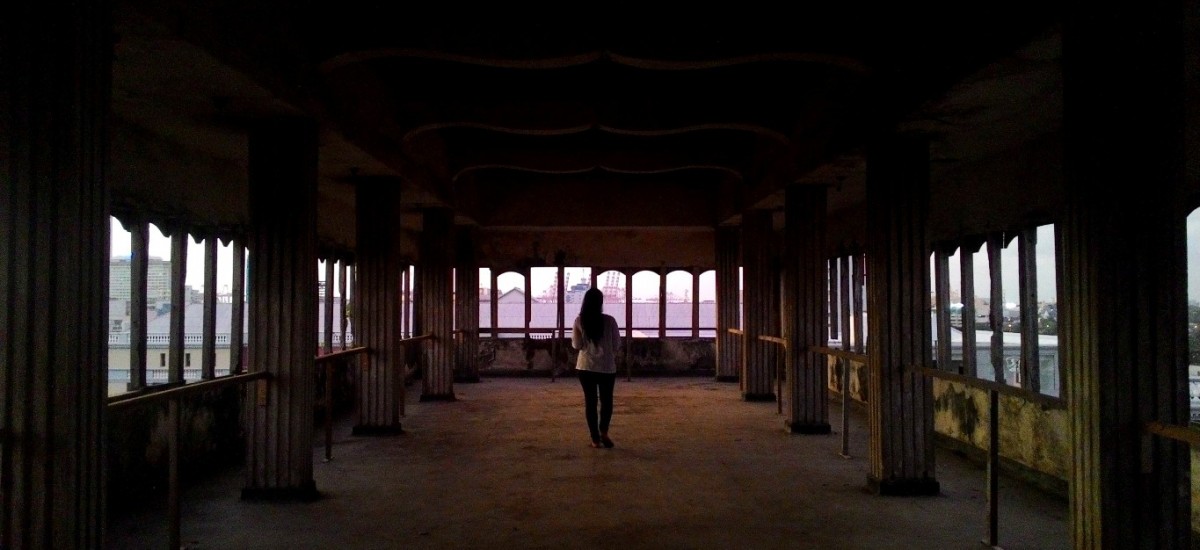We like to admit that we’ve moved past that and are moving forward but conflict scars a nation in ways that can’t always be healed. Our places are beautiful – sea, lagoon, river, forest, mountain – but our spaces are hurt – bombs, bullets, mortar, shells, fire. Our land will change with each coming rain, with water constantly on the move and leaves growing through and over the damage left by man. Brick and plaster won’t; someone will tend to their wounds, bandaging them or leaving them open for curious eyes, but they will remain marked.
The Public Library, Jaffna
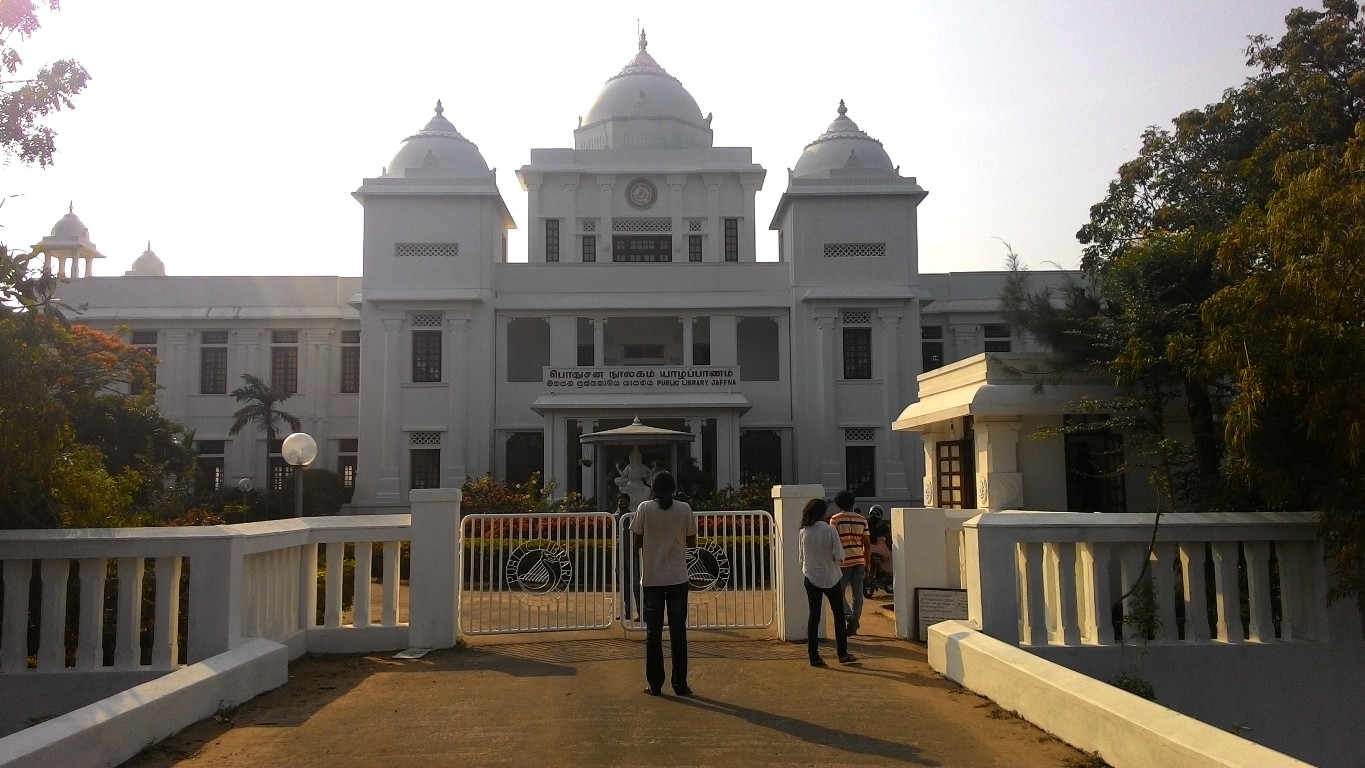
To be honest, if you didn’t hear about it or weren’t told about it, walking up to and into the Jaffna library feels like you’re walking into a perfectly normal building. Perfectly normal, its pristine white walls and the vibrant green gardens grown outside. The dark wood of the bookshelves, still new enough to still have that ‘new smell’ which almost makes you wander; the old-style building yet these shelves seem recent – maybe they renovated? Maybe, and you move on.
If you do know what happened, or if you lived close enough that you saw the destruction inflicted, you would understand – centuries worth of history, priceless and irreplaceable works, all gone up in flames. The furthest thing from spontaneous combustion – misdirected hatred.
No plaque or display or anything tells you really why everything on the inside is still ‘fresh’, why it was not so much a refurbishment as it was a rebuilding. At the entrance, you’re made to take off your shoes before stepping into the main halls. A holy place, one that has seen too much evil to be treated as anything less than sacred.
Only recently did I find out that there was a choice; to keep the damaged wing of the library and to build the new structure around it. But someone made a decision that they didn’t want people to see this. So the damage was cleared up and a wholly new landmark was drawn up in its place, a replica in the place of a ruin. Not so much a phoenix rising from the ashes as a skin graft for a burn victim; cover up the wounds with enough bandages and you might just convince others it never happened, even when you still feel the pain.
Something hangs about the whole building, in the small staircases that lead up to red-tiled balconies and in the emptiness of the top floor on the day of our visit. Once the largest library in South Asia, it still commands respect in the silence that fills the reading halls and the reverence in the way books are handled.
Respect or sympathy? That hesitance in letting your feet fall too hard should you offend the troubles space, or aggravate the wounds again.
The Rio Hotel and Cinema, Colombo
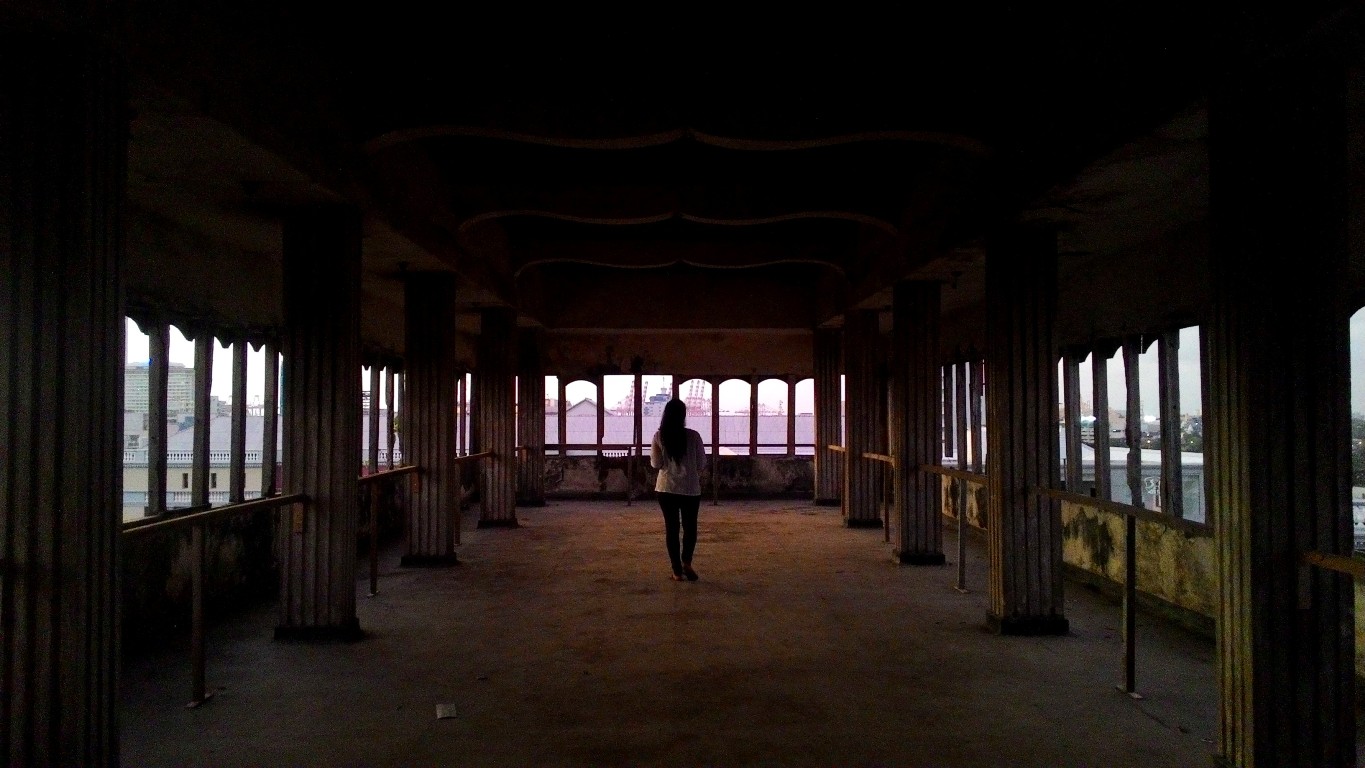
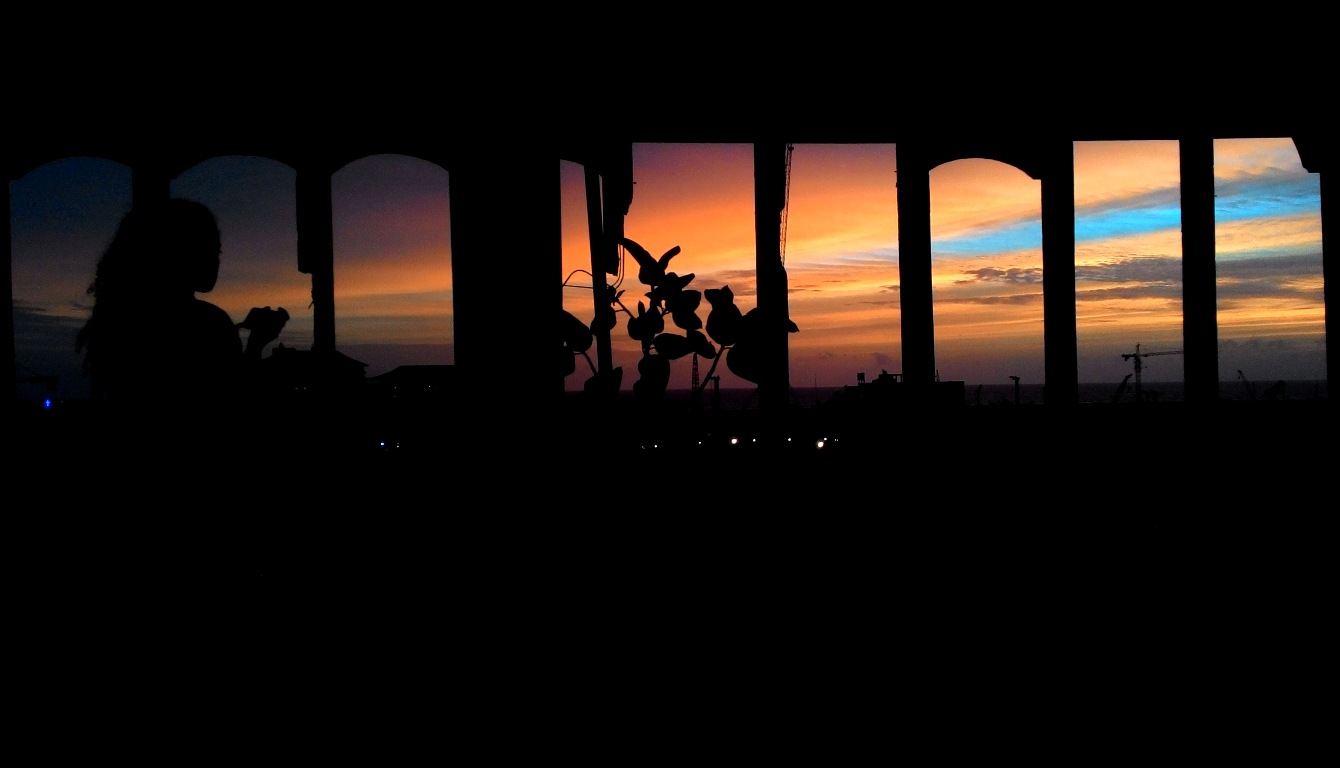
The first time I entered this space, across a creaking wooden bridge over what would have been an indoor pond, through corridors choked with dust to empty rooms, some desolate, some playing home to visitors, as the clothing lines hung with shirts and sarongs will betray.
For anyone born this side of the millennium, the Rio is a ‘dodgy-looking place’, where the only movies ever on display would be questionable titles and the crowd surrounding the area don’t look like the type you’d want to run into.
Those on the other side remember it as a shining jewel in Colombo’s heart, the place to be, a centre for glamour and class.
To the coming generations, it just might disappear completely.
It is the complete opposite to the Library; burned in the riots of 1983, the cinema occasionally screens adult films to a ‘select’ audience but the hotel itself was never revived. The fires and the prolonged neglect have tinged the whole building with a darkness that doesn’t shift even in the bright light of day. Trail your finger down the scorched walls as you follow the corridor, past dark rooms to tiny balconies, a birds-eye view to the crowded neighbourhoods below. The old fans creaking in the first-of-its-kind movie theatre, empty screen for now, looking down on aging red chairs.
The exterior, once white, has come to melt into the interior, charred black, so the whole building itself in a monochromatic blend.
Once Colombo is done fetishizing it for it’s ‘grunge’ feel, the exhibitions cleared up and the raves died down, what happens to this place?
When you walk through its halls, what do you feel?
Is it a thrill at wandering through a run-down space that satisfies your need for everything strange?
Or is it the profound sadness when you let your mind wander to the glory days of the shell of a building you walk through, the faces that made up its lost vibrance, the energy that ran through its walls, now absent?
I wandered the Rio once, when there was no exhibition or any social gathering-thing going on and it was something else. The whole place, while most certainly not ‘alive’ has a certain breath running through it; tired, ragged, about to run out.
And then you reach the top – the most incredible view of Colombo, seen in a perfect panorama on 3 sides and lined with window-arches of old. The sun begins to drop, and the trails of colour it leaves in the sky illuminate and enliven, for even a minute, this resting place.
The Two Mosques, Kattankudy
As per custom, I’m not initially allowed to enter the mosque and directed to view the inside from one of the large windows. Craning through the open spaces, my eyes take in the main wall of the Meera Grand Jumma Masjid, scarred by bullet holes and large breaks in the plaster, carnage at the holiest of holies. The altar that presides over the space has had chunks torn off it and the entire wall is speckled with wounds of varying sizes.

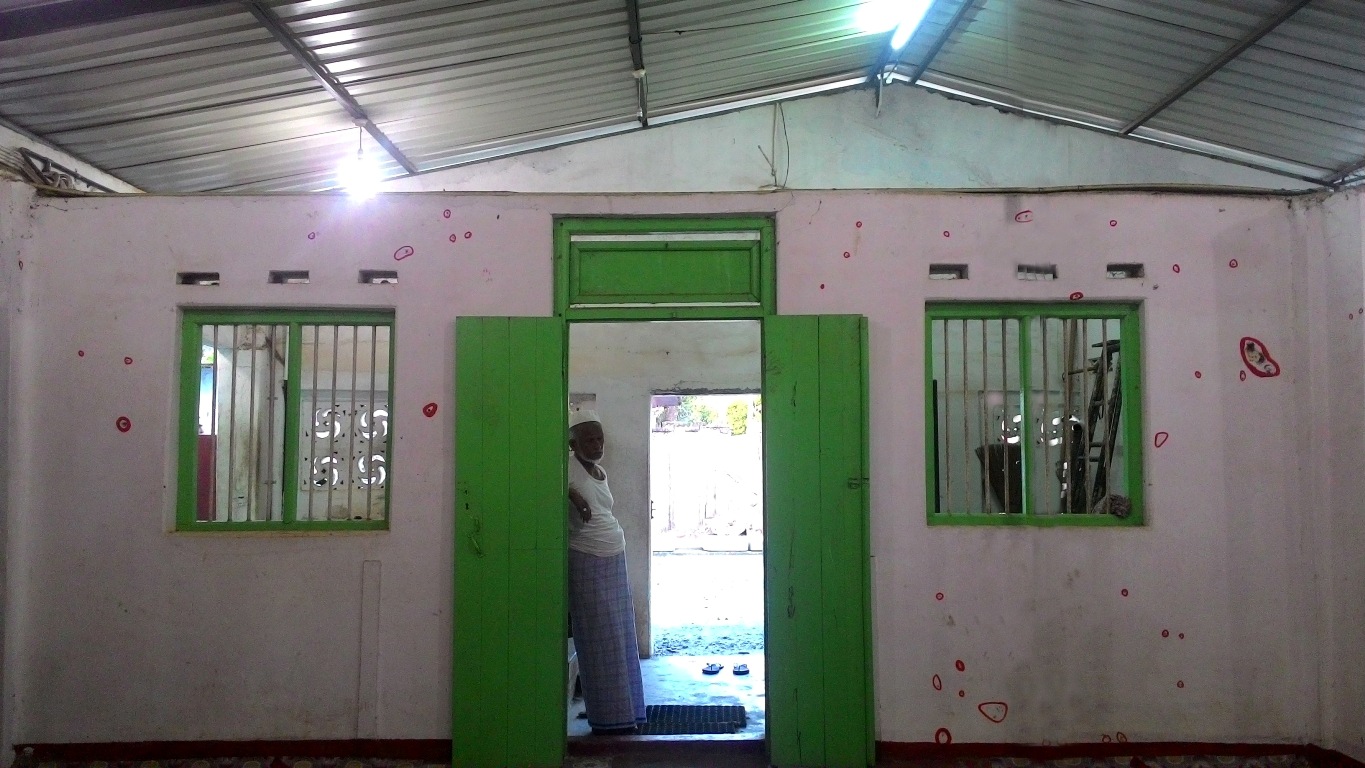
The space is almost regal in its defiance; no plaster has been used to fill in the cracks and yet, no demarcations have been placed to emphasize their presence. The holes might be the first thing you see but you still have to see them for yourself.
My heart has clenched and released multiple times. The men praying in the corners of the space, one of them seated front and centre as light falls on him from a upper window, seem perfectly at peace. Faith, I take it, is bulletproof.
The plaques outside use the word ‘martyrs’ and ‘fascists’ in their telling of the tale. Both might be so but at the end of the day, we’re all cut from the same human cloth, Sri Lankan, and I shudder to think that there was a time in history when people of our country didn’t hesitate to exact such bitter hatred on one another. Violence in the holiest month that killed 103, from ages 75 to 06 as they made the Isha prayer one Ramazan night.
Husseiniya Masjid, a little further down the road, is humbler in size yet more defiant in its response to the attack. The old uncle motions for us to enter but another one cuts him off, gesturing for us to follow him to another gate. Turns out we’d been going into the new wing, immaculate and sparkling in its new-ness, and the man seemed to know what we’d come to see – he opens the gate to reveal a smaller older wing, bearing more bullet holes. Seeing the new wing, spotless and innocent through this space, is jarring.
There is a lingering hurt here, in the way that each bullet hole has been ringed with red, marking the entry wound, glaring at you even harder in a constellation that your eyes are forced to trace. It’s almost as if someone dipped their finger in paint, a shade of red reminiscent of the blood spilled that night, and traced the outlines of the bullet holes; I will always remember so you must never forget.
The evening sets in around a resting town. The old man, prayer cap sitting firmly on his white hair, bids us goodbye with a small shake of his head. His friend closes the gate to the old wing, shutting in the marked space and trapping in the demons that still hover.
People will recommend that you visit the newly-renovated Jaffna Public Library, often leaving out the ‘old’ story that signifies its place in history.
Expect them to look at you funny when you say you’re visiting the Rio; the tuk driver confirming twice and sometimes thrice about the destination gives it away, that society forgot what brought it to this state.
A pained expression that forms on some faces when you show them your pictures from the mosques – of course, confronting reality makes anyone uncomfortable.
In the way that some want to remember, some want to forget and most want to gloss over. Are we doing justice to lives and dignity lost by remembering these sacrifices or by letting them rest in peace?
If ‘resting’ means forgetting, then no.
Monuments are built to immortalise glory so should places also be respected in their telling of the other side of the story. The age-old ‘history is written by the winners’ logic degrades the importance of these spaces and in their desolation, we overwrite their importance; how can we take pride in our best moments if we can’t feel remorse for our worst?

